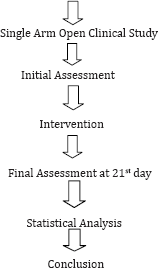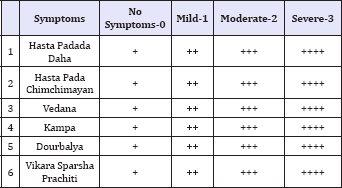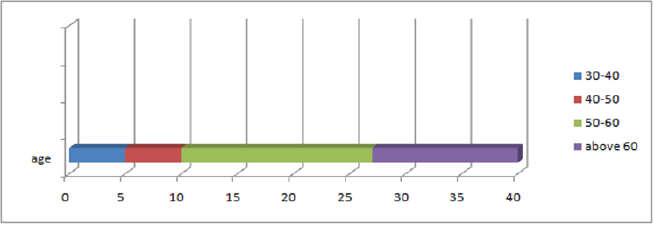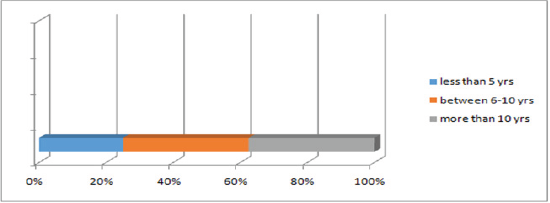- Submissions

Full Text
Advances in Complementary &Alternative Medicine
Clinical Study to Evaluate Efficacy of Aardhamatrika Basti in the Management of Madhumeha Janya Nadipratan Shotha w.r.t Diabetes Neuropathy
Ashish Mhatre* and Rambhavan Yadav
Department of Kayachikitsa, DY Patil School of Ayurveda, India
*Corresponding author: Ashish Mhatre, Associate Professor, Department of Kayachikitsa, DY Patil School of Ayurveda, Nerul, Navi-Mumbai, India
Submission: March 22, 2018; Published: March 28, 2018

ISSN: 2637-7802Volume2 Issue1
Abstract
Background: Diabetic neuropathy (DN) is a common disorder and is defined as signs and symptoms of peripheral nerve dysfunction in a patient with Diabetes Mellitus (DM) in whom other causes of peripheral nerve dysfunction have been excluded. It accounts for hospitalization more frequently than other complications of diabetes and also is the most frequent cause of non-traumatic amputation.
Objectives: To evaluate Clinical efficacy of Aardhamatrika Basti in the management of Madhumeha Janya Nadipratan Shotha w.r.t Diabetes Neuropathy.
Methodology: Aardhamatrika Basti was planned in order to have an effective and safe result. It is an observational clinical study with pre, mid and post test design, where 40 patients of DPN were randomly selected and subjected to Aardhamatrika Basti procedure for 16 days. Aardhamtrika Basti Contains Dashamoola Kashaya, Shatapushpa Churna, Saindhav, Madhu, Ashwagandha Taila.
Result: Result obtained with respect to the parameter Daha (burning pain), Chim Chimayan (tingling sensation), Suptata (numbness), Dourbalya (weakness in extremities) had showed statistically highly significant.
Conclusion: Aardhamtrika Basti presents a window of opportunity in the clinical management of Diabetes Neuropathy. Ideally this technique should be practically taught to the physicians and should be evaluated scientifically using principles of biophysics and nerve conduction studies.
Keywords:Diabetes neuropathy; Aardhamatrika basti
Introduction
The Ayurvedic physician today has to face the challenge of dealing with growing number of Madhumeha patients with or without neuropathies. Modern system of medicine has provided us some excellent facilities to detect Diabetic Mellitus with or without neuropathy. The diagnostic tools tend to be essentials parts of physicians armamentarium and should always be utilized for the welfare of patients. Even Acharya Sushruta has stated in his Sutrasthanam that he should open-minded welcome the knowledge and ideas of others [1].
A. Diabetes Mellitus the most common endocrine disorder with or without neuropathies
B. Seventh among the leading cause of acquired blindness
C. 25% cases of Diabetes complications with end stage of renal failure
D. 50% case of Diabetes complications with lower limb amputations
E. Diabetic neuropathy is relatively earlier and commonest poorly controlled complication occurring in almost every third diabetic in same form or the other
F. Diabetic neuropathy the most life spoiling diabetic complication has tremendous ramifications for the Quality of Life of diabetics
G. The classification of diabetic neuropathy is difficult because it almost certainly comprise of several different conditions
H. The intrinsic cause of diabetic neuropathy is unknown
I. NIDDM patients are more prone to suffer from diabetic neuropathy compared to other types of Diabetic mellitus
J. Diabetes neuropathy is a leading cause in impairment of nervous disorders at any stage and ages
Samprapti of Diabetic Neuropathy
Dosha prakruti
A. Vata-Samana Pradhan Vyan-Rukshatah-Laghavatah- Chalahgunatahavikruti
B. Pitta-Pachaka Pradhan sadhaka pitta-Ushnatah- dravyatah-tikshnatah-gunatahavikruti
C. Kapha-Kledaka Pradhan kapha
D. Dhatu Prakruti-MajjaPradhan All dhatu(except Asthi) with vasa, Lasika, ojas and Ambu
E. Agni Prakruti-Majjadhatvagnimandya
F. Adhisthan-Mastishkapradhanvatanadi
G. Strotas-Majjavaha-mutravaha and udakvaha
H. Strotusdushti Lakshanam-Sangaatmak
I. Vyadhi Utpatti Sthanam-Majjadhatum-mastishka- vatanadi
J. Vyadhi Swabhav-chirakalin
K. Vyadhi Marga-aabhyantar-marmaasthi-sandhigata
L. Vyadhi Vaisheeshtaya-Kampa-Dahavata, prachiti, hasta padagata
M. Pratyatma Lingam-Chimachimayanvatapratichi
N. Dhatugataavastha-sarvadhatugata
O. Sadhya-Asadhyatva-Kruchchrasadhya
P. Chikitsaparinama-Chirakalin proper management
Q. Rugna Vayatahsambadh-Vardhakyavastha>Yuvavastha (Relating to age factor)-(old age)(young age)
R. Sex-female<Male
S. Sankamarna-Non-infection
T. Aanuvansheekadisambadha-Aanuvanshikavyadhi
U. Dhatuprabhav-All Dhatuskshayajanya (including Aasthidhatu in late stage)
Thus the Dhatushaithil-Dhatu Kshaya Dhatu Ksharanprakriya and Dosha dushti are the major factor resulting in diabetic neuropathy Management should satisfy the following aims:
A. To check Bahudravataushna and rukshaguna of Kapha pitta and Vata respectively
B. To correct Bahuadadhatu of Medadhatu
C. To provide strength to sthanaeg. MajjagataAvastha
D. To provide nourishment of Dhatus
E. To check Dhatuksharan and Ojakshaya
Aims and Objective
A. To evaluate clinical Efficacy of Aardhamatrika Basti in the management of Madhumehajanya Nadipratan Shotha w.r.t Diabetes Neuropathy
B. To undertake clinical study of prameha Upadrava with special reference to diabetic neuropathy and its management with herbal medicated Takradhaara
C. To review the view on Diabetic Neuropathy as per modern medical science with latest up to date literature
Material and Methods
A. Research Place: Dept of Kayachikitsa, OPD/IPD DY Patil School of Ayurveda
B. Sample Size: 40
C. Type of Study: Single Arm Open Clinical Study
Ingredients of Aardhamatrika Basti (Table 1)
Table 1: Ingredients of Aardhamatrika Basti.

A. Dashmoola Kwath-500ml
B. Shatapushpa- 10gm
C. Saindhavalawana-10gm
D. Madhu-100gm
E. Taila(Ashagandhadi Taila)-100ml
F. Madanphala Churna-50gm
Inclusion Criteria
A. Well established case of Diabetic Neuropathy with good control of blood sugar were selected for the trial after proper examination
B. Diet: Advised by physician or hospital made diet
C. Age: 20 to 70
D. Sex: Male and Female
Exclusion Criteria
A. Patients with severe acute complication of Diabetic mellitus requiring emergency management
B. Patients with major diabetic complication eg. Retinopathy, Nephropathy etc
C. Pregnancy in female patients
D. Patients with systemic and metabolic diseases eg. Koch's, kidney diseases, hepatic and haematological disorders
Study Design

Neuropathy disability score a modified form of the Neuropathy Disability Score (NDS) is a relatively simple, quick clinical assessment tool that aims to combine a number of clinical tests to provide an assessment of the risk of neuropathic ulceration. Both feet should be tested and scored independently, and the results added together. The maximum score for the modified NDS is 10, indicating a complete loss of all sensory modalities and absent reflexes. A score of six or more has been found to indicate an increased risk of foot ulceration [2-5] (Table 3-8).
Assessment Criteria
Subjective parameters (Table 2)
Objective parameters
Table 2: Subjective parameters.

Observation and result (Table 3)
Table 3:

Subjective parameter based on Kruskal Wallis non parametric test (Table 4)
Neuropathy disability score (NDS) (Table 5)
Table 4: Subjective parameter based on kruskal wallis non parametric test.

Table 5: NDS: Neuropathy disability score.

Graphical Representation
Table 6: Age wise distribution.

Age wise distribution (Table 6) (Figure 1)
Table 7: Sex wise distribution.

Sexwise distribution (Table 7) (Figure 2)
Chronicity wise distribution in patients of diabetic neuropathy (Table 8) (Figure 3)
Table 8: Chronicity wise distribution in patients of diabetic neuropathy.

Discussion
A. According to Age wise distribution, Patients between age group of 50-60 more patients are prone to Diabetes Neuropathy
B. Patients having Hastapada Daha have 44.68% improvement
C. Patients with Hastapada chimchimayan has 64.74% improvement
D. Patients having Dourbalya has 72.2% improvement
E. Improvement in NDS score was 32.3%
Aardhamatrik Basti prevents Dhatu-Shaiyhilya and Dhatupaka. It maintains the equilibrium of the body tissue with Hrdya and prevents exhaustion or Dhatupaka to prevent loss of Ojas, and nourishes all Dhatu tissue including Mansa-Majja and Shukra and enhances more strength to the Dhatus at the cellular levels and increase the proper cellular metabolism in stage of chronic stage of Diabetic neuropathy [6-8].
Figure 1: Age wise distribution.

Figure 2: Sexwise distribution.

Figure 3: Chronicity wise distribution in patients of diabetic neuropathy.

It produces the following changes
A. Cure the vitiated or aggravated Dosha (elimination of circulatory waste products)
B. Increases digestive capacity (altered metabolism-Agnisanrakshan)
C. Purification of Koshtha and remove the constipation (Koshthashudhi)
D. It provides micro-nutrients to build the body tissue and help strengthen the host defence mechanism without increasing circulatory levels of sugar, facts and metabolities
E. Enhances the function of all Agnisthul and Sukshmaagni(AamaPancha)
F. Production of better Dhatus and Upadhatus(immono- modulatory action-Dhatusanrakshana)
G. Enhances strength of body(adaptogenic activity)
H. Proper functioning of nervous tissues(improvement of micro circulation by modulation of macrophage function-Stroto- shodhan)
I. Increases the resistance of body (Dhatuvardhan- maintain tissue regeneration)
J. Delays the aging process (Rasayan karma)
Acknowledgement
This particular clinical study was conducted with the help of DY Patil School of Ayurveda, Dept of Kayachikitsa.
Ethical Clearance
This clinical study was ethically cleared by institutional ethical committee. The drugs used in the study were authenticated by Dravyaguna and Rasashashtra Dept. of DY Patil School of Ayurveda.
References
- Charak samhita of agnivesha based on chakrapanidattas ayurvedadipika. Siddhi Sthana, 12th chapter, Volume 2, Caukahamba Sanskrit Series, Varanasi, India.
- Nidan M (1954) In: Sudarshan S (Ed.), Caukahamba Sanskrit Series, Varanasi, India.
- Tripathi B (1999) Ashtang hridaya of vagbhatta chikitsa stana. Caukahamba Sanskrit Series, Varanasi, India.
- Charak Samhita of Agnivesha revised by Charak and Dridhbala. Prameha Chikitsa Chapter 6/26, Caukahamba Sanskrit Series, Varanasi, India.
- Bhaisajya Ratnavali, By Prof Siddhinandan Mishra-Prameha roga adhikar(37 chap), slok no 17.
- (2009) Govinda Das Prameha Chikitsa 37/17 Bhaisajya Ratnavali, Caukahamba Sanskrit Series, Varanasi, India.
- API Text book of Medicine (2003) In: Siddharth N (Ed.), (7th edn), Association of physicians of India, India.
- (2006) Davidsons principle & practice of medicine. In: Nicki RC, Walker BR (Eds.), (20th edn), Livingstone Elsevier Limited, London, UK.
© 2018 Ashish Mhatre, et al. This is an open access article distributed under the terms of the Creative Commons Attribution License , which permits unrestricted use, distribution, and build upon your work non-commercially.
 a Creative Commons Attribution 4.0 International License. Based on a work at www.crimsonpublishers.com.
Best viewed in
a Creative Commons Attribution 4.0 International License. Based on a work at www.crimsonpublishers.com.
Best viewed in 







.jpg)





























 Editorial Board Registrations
Editorial Board Registrations Submit your Article
Submit your Article Refer a Friend
Refer a Friend Advertise With Us
Advertise With Us
.jpg)






.jpg)













.bmp)
.jpg)
.png)
.jpg)














.png)

.png)



.png)






